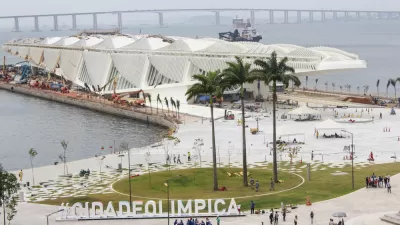For China, the Olympics represent a struggle between letting people in and controlling what they see and do. This is a problem, writes Andrew Yang, that implicates the Olympics-related architecture in a bad way.
"For China, the Olympics has been both a galvanizing force and an exercise in pride, partly deserved, partly not."
"Recently, however, the exercise has not gone entirely according to plan. In spite of their inevitability, the mass protests in Tibet, Xinjiang (the Muslim part of Western China), and Mongolia still caught the government off their usually rigid guard. Even more unpredictable has been the tumultuous time the government has had trying to control the coverage of these events. And when widespread public sympathy during the Sichuan Earthquake led to a huge demand for news, the state could no longer reasonably control the local and foreign media."
"The Olympics have laid bare the illogic behind the government's approach. It invites the world in, but then restricts entry for fear that a bunch of Teva-wearing hippies might show up and disrupt the games. Of course there will be controversy-China is a totalitarian state, after all-but in courting the public stage, China is also courting widespread scrutiny of its atrocious human rights record."
"Above all, what I blame most on the Olympics is how it implicates architecture in the fabrication of this whole spectacle, and even uses it to mask real urban problems confronting Beijing. Without a doubt, OMA's CCTV and Herzog and de Meuron's Olympic Stadium will remain masterpieces in the landscape of the city. But within its Soviet-inspired planning fabric, with its concentric highways lapping outward from the hub of the Forbidden City, huge monolithic-style building threatens to add to the isolation of Beijing's vast alienating stretches. Anyone who has traveled through rush hour there, where it routinely takes 60 minutes to budge five miles, will have contemplated the poor planning implicated by this level of congestion."
FULL STORY: Protest: China's Olympic Syndrome

Planetizen Federal Action Tracker
A weekly monitor of how Trump’s orders and actions are impacting planners and planning in America.

Map: Where Senate Republicans Want to Sell Your Public Lands
For public land advocates, the Senate Republicans’ proposal to sell millions of acres of public land in the West is “the biggest fight of their careers.”

Restaurant Patios Were a Pandemic Win — Why Were They so Hard to Keep?
Social distancing requirements and changes in travel patterns prompted cities to pilot new uses for street and sidewalk space. Then it got complicated.

Platform Pilsner: Vancouver Transit Agency Releases... a Beer?
TransLink will receive a portion of every sale of the four-pack.

Toronto Weighs Cheaper Transit, Parking Hikes for Major Events
Special event rates would take effect during large festivals, sports games and concerts to ‘discourage driving, manage congestion and free up space for transit.”

Berlin to Consider Car-Free Zone Larger Than Manhattan
The area bound by the 22-mile Ringbahn would still allow 12 uses of a private automobile per year per person, and several other exemptions.
Urban Design for Planners 1: Software Tools
This six-course series explores essential urban design concepts using open source software and equips planners with the tools they need to participate fully in the urban design process.
Planning for Universal Design
Learn the tools for implementing Universal Design in planning regulations.
Heyer Gruel & Associates PA
JM Goldson LLC
Custer County Colorado
City of Camden Redevelopment Agency
City of Astoria
Transportation Research & Education Center (TREC) at Portland State University
Camden Redevelopment Agency
City of Claremont
Municipality of Princeton (NJ)



























